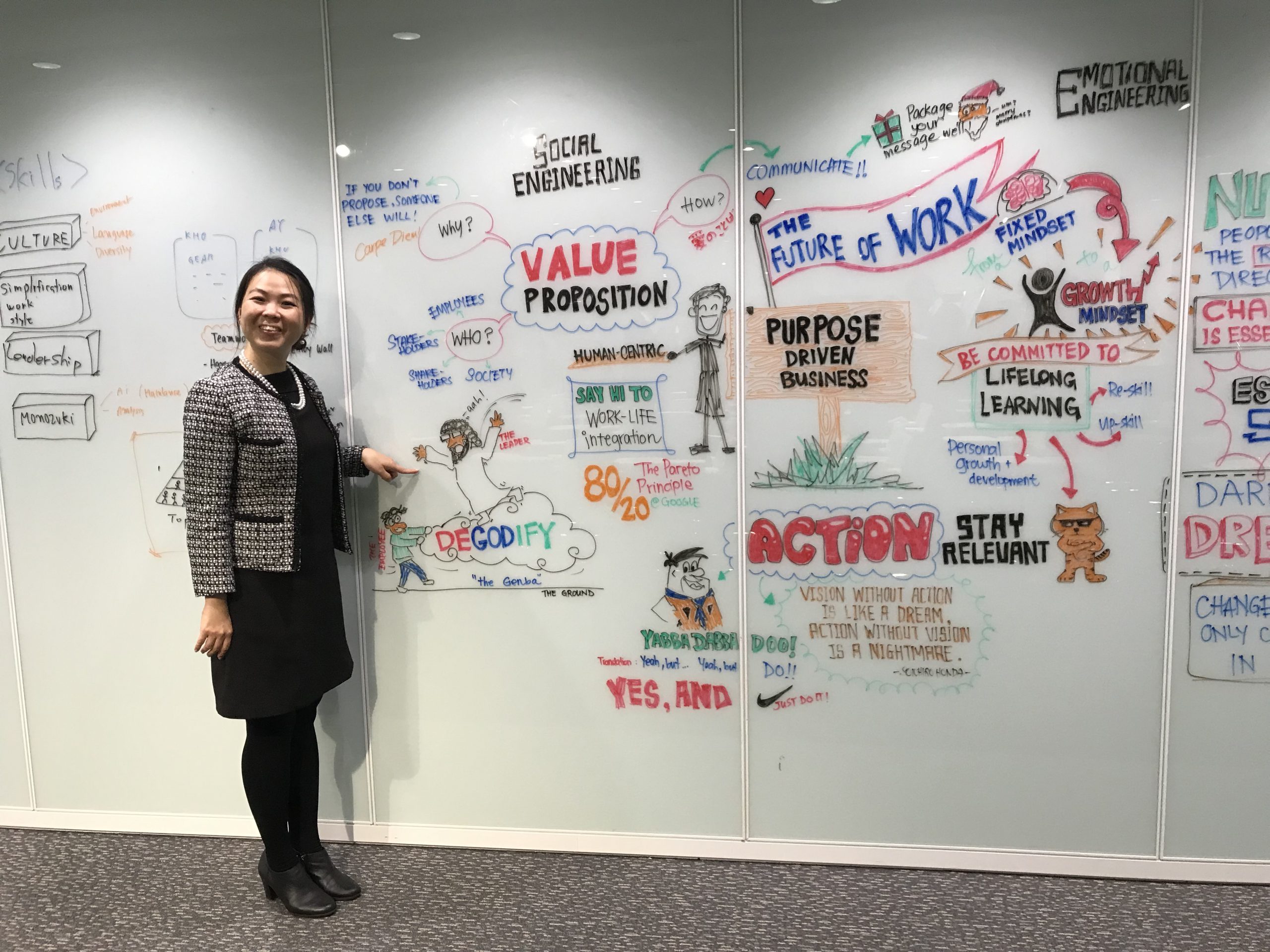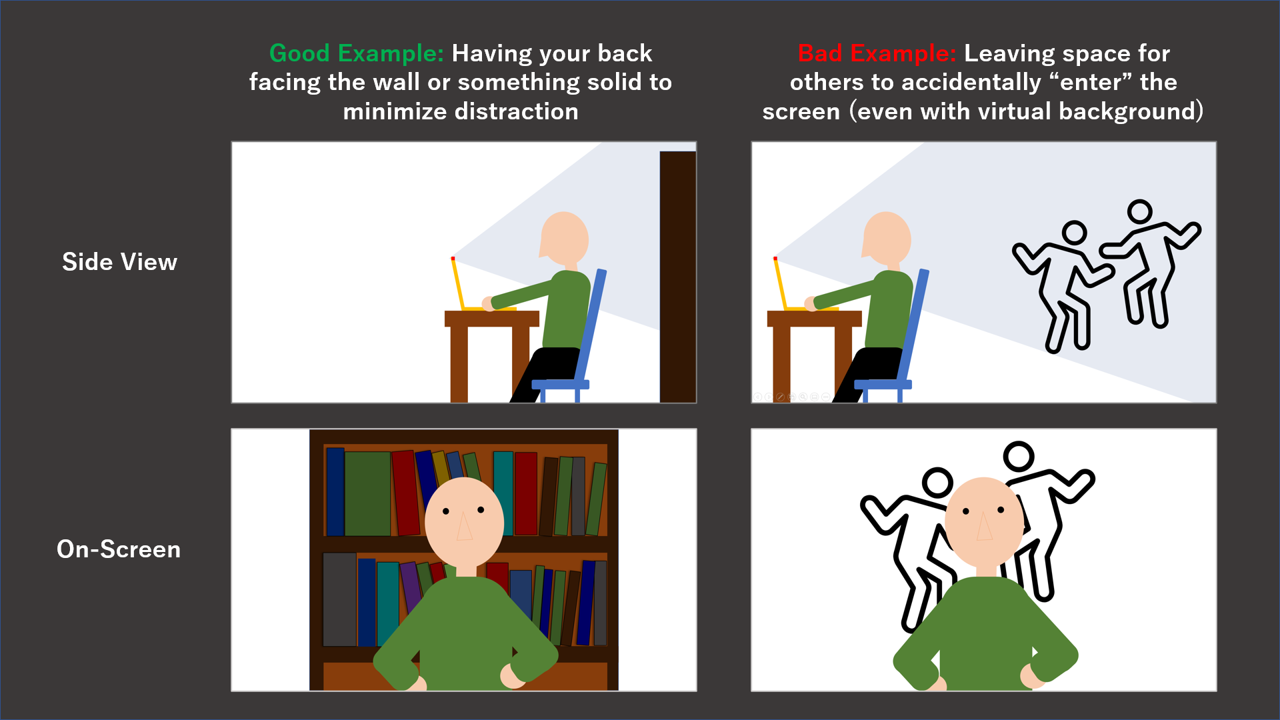Can you teach business without business experience?
You can teach the business theory and refer to some practical cases illustrated in business management literature. However, the best practical experience that can benefit learners more is what the professor himself or herself went through. There was a time when teachers teach how they had learned, with little regard to the student’s needs. As the world changed, today’s society promotes an agile teacher model. In this model, the teacher — be they traditional classroom teachers or coaches, speakers or mentors – adapt how they teach to meet the varying student needs.
The Nagaoka Review had the opportunity to speak to Michelle Lim, a Design Thinking professor for MBA and Ph.D. students and The Nagaoka Review Editor-in-Chief about her experience working in multiples areas and her thoughts about her unique teaching method and relations with students.
NR: Could you share with us about yourself and what you do?
ML: I am Michelle, an Instructional Designer from Malaysia based in Japan. I teach Design Thinking to MBA and Ph.D students in Japanese universities. I also teach other courses such as Business Communication, Presentation, Customer Journey and Creative Leadership in various universities. I collaborate extensively with universities and business organizations to facilitate the expansion of their horizon through creative thinking. I have been in Business Consulting in Japan for over 6 years now and I specialize in Creative Consulting. It is rather difficult to explain what I do, but in short, I help businesses break creativity barriers to come up with innovative ideas and solutions.
I am also a Corporate Trainer with over 10 years of experience in the Learning & Development side of Human Resources and a HRDF-certified trainer in Malaysia. I used to do a lot of graphic facilitation and recording in the pre-COVID days but now, we spend more time doing online delivery, so we have to adapt our facilitation style with the times.

Graphic Facilitation & Recording: An example of Michelle’s graphic recording during a corporate engagement in Tokyo. Image courtesy of Cristian Vlad.
A huge part of my work revolves around communications, in particular digital communications. I write and review a lot for the Nagaoka Review, being the Editor-in-Chief of the social site. I find myself consistently connecting with new individuals to find interesting insights to be shared. We focus a lot on sharing thought leaders’ view from various industries to enrich our readers’ exposure to the world beyond. We also help create awareness and build digital presence for individuals and organizations.
Education in the 21st Century
NR: We have heard from students that you have your unique teaching method. How would you describe the way you manage classes at the university?
ML: Thank you for your kind compliment. While I do not think of it as being unique, I’d say that I have a different approach in managing my classes. My classes are usually crafted to allow students to speak at least 50% of the time. Depending on the dynamics of the class, I would adjust accordingly to ensure sufficient time and opportunity is given for students to participate in the lesson.
One example would be the International MBA class I teach at GLOBIS University. Students in the class are geared to participate due to the nature of MBA classes. In this environment, my role is to create enough opportunities for people to share their ideas and sometimes allow some head-butting and idea clashes to happen to enhance the learning experience. In another environment whereby students are more used to traditional education, I would start off by sharing more materials and information and segue into simple, targeted questions for students to share their thoughts. Bottomline is, having these small and quick wins would increase a person’s confidence in participating.
With my Ph.D students, the environment is really interesting. We would have a combination of students who are ready to share their ideas while others find it difficult to have a voice in the class. It is all about “reading the air”, as they say in Japan, trying to establish the situation and respond to it.
NR: When you say it is important to “read the air”, what do you mean by that?
In essence, everyone has a different way of expressing their thoughts or ideas. And it is my job to understand how my students think and what works well for them. In short, I have to “read the air”. Some students feel more comfortable when they are given the stage or when they are asked to speak. Some others will not hesitate to jump at any opportunities to share their thoughts. As an educator, my job is to balance the conversation, giving opportunities and support to ones who are quieter to share their thoughts whilst maintaining the engagement with students who are very eager to share.
What I found most beneficial for students who are more shy or hesitant to speak, is the chat function on Zoom during the online class. I would encourage students to drop their comments in there and I would read it out loud. And for those who are really struggling due to sudden change in teaching style, I would send them a personal message and encourage them to drop some comments to me and I would share their thoughts on their behalf.
NR: How do you help increase students’ confidence in participating in class?
ML: That is a good question. My classes are usually conducted in English. Some students may feel hesitant having to speak up or to type in English due to various reasons such as language confidence or the fear of misspelling. In most of my classes, my first message to all students remains the same: This is not an English Grammar class. I love seeing the huge sigh of relief on their faces. That is one big step toward creating a psychologically safe learning environment for them.
Besides that, having a positive attitude and mindset when conducting classes is crucial. When the teacher shows signs of frustration or displeasure, students will feel it and it would affect the mood of the class. Being genuine about wanting to help students to improve is also an important aspect, because people can feel your level of authenticity.
”An important aspect of teaching is the ability to coach and to motivate people to achieve their goals. Goal-setting is very important at the start of each class, so students will know where they are headed for the next one, two or three hours of the class.
Michelle Lim
Building a Conducive Educational Experience
NR: How would you describe the interaction between you as a professor and your students?
ML: In short, I would say that there is less distance between me and my students. I enjoy having conversations with my students like we are friends, rather than to establish authority and increase the distance between us. My personality plays a huge role in my interaction style. I prefer honesty and enjoy having enough psychological safety to be myself. At the same time, my experience at work validated my thoughts; it is important to reduce the barrier to connection between people.
Over the years, I have worked with many people and found that an environment that offers psychological safety helps people to feel more included and accepted, opening up more opportunities for better collaboration and stronger bond. But an important pre-requisite to creating such an environment is the need for everyone to get to known their own self first. In my class, I highly encourage my students to discover interesting things about themselves such as their learning style or personal biases. I believe we should not be ashamed of our personal biases, but acknowledge that it exists and be mindful about it. Having this knowledge also opens up to deeper insights and discovery.
I would do my best to create a conducive environment for people to encourage one another to speak up and work together. While it is a difficult thing to establish, this is the first thing I aim to create at the beginning of the first lesson. If we were to set the tone right at the beginning, other things will fall into place naturally and people would adapt quickly.
NR: How would you describe your typical interaction with students?
ML: My word choice is more casual and friendly, aimed at creating a friendly environment to enhance the learning experience. I encourage student-to-student interactions a lot in the class, allowing them to take on the role of the class facilitator when needed.
Outside of class, my students and I have a good relationship. Students could send me questions related to the class or some other topics such as seeking internship opportunities, searching for a mentor, or just seeking for opinions. We are usually connected via LinkedIn. I also enjoy going for Hanami during the cherry blossom season, or even karaoke sessions to learn more about them outside of the classroom. At times, we would go out for winter sports together! Now, I am just hoping for the situation to improve so we could once again have face-to-face gatherings instead of just seeing each other on screen!
Getting to know students better beyond the classroom walls. Image courtesy of Michelle Lim.
NR: What motivates you to have a closer relationship with your students?
ML: I am a big believer of empathizing with the learners, understanding the challenges and limitations faced. As I am not too far away (age-wise) from my students in general, I found that many students find it easier to talk to me. By having better communication, I would usually come across interesting insights that other educators do not have access to. And these insights are the reason for my different teaching method, so to speak. So far, my teaching method has been effective, even though it is a subjective topic!
Of course, not all students would be comfortable having less distance between their professors. In that way, I would respect the student and interact with them in a more formal, distant manner if it works better. But occasionally, I would still drop a general message to everyone in class to ask how they are doing. So, everyone has equal chance to getting access to me if they have questions or need help.
Combining Business Experience and Education
NR: Coming from business consulting background and an MBA in hand, would you say that the business experience you have gained over the years have helped you become a better teacher?
ML: My answer would be a big yes. Having access to first-hand experience working with businesses and business professionals have helped me in many ways. Being in business consulting, we work with clients from all around the world. One of the first things we had to learn was to be as observant as possible to notice cultural differences and adapt quickly. Besides that, I find myself being exposed to a variety of knowledge in areas and fields I was previously unaware of.
With the learning opportunity I have gained in business, I find myself being able to answer my students’ questions better and offering them a different point of view. In consulting, we have to keep ourselves updated on what is happening in the real world. And all these issues and challenges we read; they find their way into our conversation in class. Through feedback from students, I have also found that they really enjoy having the chance to discuss more about current news. It makes the class more practical and up-to-date!
NR: Did you plan to first start off your career in the corporate sector and then move on to academia?
ML: In this regard, I would like to quote Steve Jobs’ quote at the commencement address at Stanford in 2005. “You can’t connect the dots looking forward; you can only connect them looking backwards. So, you have to trust that the dots will somehow connect in your future. You have to trust in something — your gut, destiny, life, karma, whatever.”
I did not plan to be in academia, but my past experiences were steppingstones that guided me toward my current path. Just like how I was a Communications graduate majoring in Film and Television (FTV), thinking I would not use the skills learned but ending up working on Design Thinking projects and spearheading prototyping classes while teaching my students how to sketch storyboards. Or how I was taught by my boss in the FMCG sector that “less is more” when it comes to product script. When selling to customers, use analogies and stories to capture their attention instead of focusing on highly polished English scripts filled with jargons.
”All these experiences led me to become a better communicator, and now a better educator. But of course, I have so much more to learn. And the biggest being time management!
Michelle Lim
NR: What is the best way to capture students’ attention in class?
ML: All in all, I would say that the idea of making education as relatable to real life is the “sticky factor” that would help students to have a better grasp of what they are learning. Analogies are a good way. Or surprising quotes. Those always work well! As the saying goes, “Laughter is the best medicine”. Do not be afraid of throwing in some humor in class. But of course, it takes some tact and experience in executing it well. It would be bad to laugh when someone is struggling to make a point across, but laughing at our own self when we make a mistake (e.g. sharing the wrong screen or accidentally turning on the video filter) would help lighten the mood and create a psychologically safer environment to let others know that it is okay to make mistakes, as we are human.
Online vs. Face-to-face
NR: There is a huge debate in academia on which is a better way to conduct classes. What is your take on it? Which do you prefer?
ML: After a year of almost teaching exclusively online, I am starting to miss having face-to-face interaction with my students. But I’d say I gravitate towards online classes more. Face-to-face classes are great for Design Thinking classes when we physically build prototypes. But through many trials and errors, as well as learning and sharing from other lecturers, we have learned how to make online classes work pretty well too. I personally love drawing on the physical whiteboard because it easy to illustrate my idea, but another instructional designer introduced me to the “annotate” function on Zoom and my online delivery experience improved tremendously. I also invested in a touch screen laptop that comes with a pen, so these tech solutions did help me a lot. As we have talked earlier about using the chat function on Zoom, I cannot stress how much this chat function is heaven-sent. Not only does it help the shy and quieter students to interact, I like how students are increasingly using this to help each other. Some students will help me to answer another student’s question during the class. I like that sense of community that I see in the class.
Besides that, face-to-face classes would limit us to have only one conversation at a time. I like how we could utilize the chat function to drop a personal message to a student who is looking confused, instead of embarrassing them by accident when we ask them directly in front of other students. Parallel discussions could happen too, with the creation of breakout rooms and the later update done whereby participants could choose which rooms they would like to go.
Being an Online Rockstar
NR: What is your typical online setup like?
ML: That’s an interesting question. Recently, a student shared with me about her online class experience with one professor missing face-to-face class so much, she has trouble using the Presentation mode. During screen sharing mode, she would fluster so much that she would stop sharing just to see the students’ faces. The first thing that came to my mind was to invest in a second screen for the professor!
My setup: Minimum, two screens! You can’t function with just one small screen! The second would be lighting, I would always ensure that my face is properly lit so my students can see my expression better. And lastly, please ensure your background is presentable (as a professor).
Here is an example of my setup. For classes with less than 20 people, I would opt for 2 screens. A bigger monitor means having more space to fit the Zoom participant video screen, the chat box and a part of my Word document with notes to cut and paste into the chat group. The other screen for presentation slides. I always have a back-up PC (or in this case, a tablet PC) in case we experience technical difficulties!

Image of Michelle’s setup with two screens and a third screen (tablet) as a back-up in case of IT failure. Image courtesy of Michelle Lim.
For bigger classes or seminars, I would project a third screen on to my tablet and use the big monitor screen dedicated for the zoom participants to gauge their facial expression. My smartphone then becomes my backup to ensure I am projecting the right screen.
I rarely use the virtual background because certain portion gets “eaten up”, making it uncomfortable for viewers. To use real background, I would sometimes spend time trying to tidy up my background. One important tip if you’re doing an online class with other people in the area, always ensure that you angle your camera towards somewhere with minimal distraction. Sometimes the virtual background might fail you, and the person walking behind might just pop up on screen.

The importance of ensuring minimal distraction in the background. Image courtesy of Michelle Lim.
Managing Diversity and Inclusion in Education
NR: How do you manage Diversity and Inclusion in class?
ML: When we talk about Diversity and Inclusion in business organizations, we would see a lot of effort being done by organizations in trying to engage all levels of employees. When I look at education, I somehow do not see this happening. In one of my part-time online class, we have mothers as students joining us from 7-10pm. For those with children, you would probably understand the amount of attention children need from their parents, especially their mother. Just today, a student was about to present her group’s final presentation when her daughter had to go to the bathroom. I feel bad seeing how mothers would always apologize for the inconvenience caused, having to juggle between life, work, and studies. Motherhood is a natural part of life and I really hope to see it being normalized.
In one of our classes, I suggested to the mothers to allow their children to participate in the prototyping session. And I was happy that the entire class was kind and empathetic enough to be supportive of their classmates. It made me realize this important point: as educators, we set the tone of the class. When we embrace and include others in the class, our students will follow suit. We have to always be aware of our decisions and actions in creating a conducive environment for everyone.
NR: What other challenges do you see in online class delivery?
ML: Many people have cited the lack of information as a reason. After a year of going through the challenge, I realized, as an educator that I cannot say that we lack information or resources. In fact, there are tons of information online! One example is the Faculty Lounge by Harvard Business Publishing, offering free webinars to educators to up their ante and adapt better. Instead, the biggest factor at play is the lack of proper communication and direction. When it comes to communicating the next steps, everyone is very cautious. At the onset of the pandemic, people were not sure how long this would last. Being in a traditional environment, as education has always been, the biggest disruptions we have seen are probably the advent of the Overhead Projector (OHP) and the transition to the PC, projector and screen. Huge change is not something readily welcomed.
When educational institutions bank on the situation to revert to “the norm” (i.e. pre-pandemic situation), little effort is being put to emphasize on the need to adapt to online teaching. When we as leaders set the tone, others will follow suit. When we are unsure, everyone else becomes unsure. One thing we really need in the education industry is the fact that the times are a changing and we need to adapt, fast. What support could we offer to our educators so they would not feel left out or out of touch when it comes to adapting to a new way of teaching? Investing money into better IT infrastructure alone is not enough. There needs to be better scaffoldings placed around the transition, creating psychologically safe environment for professors to have enough time to experience (and experiment with) online class without the fear of failure.
”The last thing we want is to embarrass our professors in front of their students. But it seems like the action taken by many educational institutions seem to hint otherwise!
Michelle Lim
I am thankful for having a head start in online teaching with a remote IT support team set up to guide us through. In essence, the team knows of all the potential setbacks and would periodically share manuals and tips crowdsourced from other instructional designers and lecturers/professors. And we have self-starters within the group of instructional designers (IDs) who would explore Zoom at their own time, creating a “cheat sheet of shortcuts” that is distributed amongst other IDs to facilitate faster group learning.
Why Education?
NR: We find it interesting that you would consider teaching after having spent many years in a corporate environment. Why?
ML: Since I was a child, my father always insisted on me becoming a teacher. But the middle child in me was rebellious, trying to stay away from this “natural calling” my father noticed in me since I was young. Fast forward more than three decades later, I found myself jumping back into Education. A huge push came from the frustration I felt, as what Sir James Dyson described in his determination to create great vacuum cleaners. I was frustrated about where education is heading, and how the younger generation are shackled by old knowledge but expected to perform in a dynamic and fast-paced environment.
“Be the change you want to see in the world.”
Mahatma Gandhi
I was frustrated by the lack of psychological safety in class, the need to restrain one’s creativity in order to fit into the “norm” and later joining the workforce only to be told that we are supposed to harness our creativity to find better solutions to improve the world. And I thought to myself, “Why don’t I just do what I do, and create a different learning environment?”
NR: Who or what inspired you to think this way?
ML: I am always reminded of the famous quote our school Principal, Mrs. Gracie Tay used to iterate in all her speeches. Her rendition of Sir Winston Churchill’s famous quote, “Ask not what the school can do for you, but ask what you can do for the school” still rings well in my ears. I believe I am finally going beyond asking what I can do for the school, to put into action what I can do to create a different learning environment to suit the changing needs in this VUCA world.
”I had some kind, empathetic and understanding teachers in school who helped made my experience in school better. They have inspired me to see the best in people, always lending a helping hand whenever I can, and be the one to set the right tone so others can follow. Here is to hoping that we as little individuals could create tiny but endless ripples in Education to help each other grow and lead more meaningful lives!
Michelle Lim













